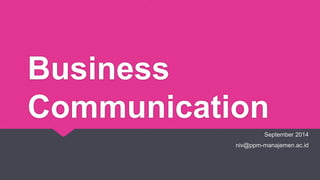Business Communication (from Bovee & Thill Ch1-2)
- 1. Business Communication September 2014 niv@ppm-manajemen.ac.id
- 2. Why should you CARE about the way you communicating?
- 3. Because it’s your career on the line!
- 6. It’s also important for your company. Find out why!
- 7. relationship influence productivity financial earlier warning decision making marketing engagement
- 8. Communication in Organization: Formal
- 10. Communication in Organization: Informal
- 11. Let’s play a communication game!
- 12. Communication Process: 1 Sender has an idea
- 13. Communication Process: 2 Sender encodes the idea to a message
- 14. Communication Process: 3 Sender produces message in a medium
- 15. Communication Process: 4 Sender transmits message through a channel
- 16. Communication Process: 5 Audience(s) receives the message
- 17. Communication Process: 6 Audience(s) decodes the message
- 18. Communication Process: 7 Audience(s) responds to the message
- 19. Communication Process: 8 Audience(s) provides feedback to the sender
- 20. Sender has an idea Sender encodes idea into message Sender produce message in a medium The message is sent through a channel Audience receive the message Audience decodes the message Audience responds Feedback Potential problems: Solutions: Potential problems: Solutions:
- 21. Analyze what can go wrong (potential problems) in the process, and propose solutions to address the potential problems.
- 22. BizComm 1.0 Publication. Lecture. Intrusion. 1 direction. 1 to many. Control. Low message frequency. Few channels. Info hoarding. Static. Hierarchical. Structured. Isolation. Planned. Isolated. BizComm 2.0 Conversation. Discussion. Permission multidirectional. 1 to 1, many to many. Influence. High message frequency. Many channels. Info sharing. Dynamic. Egalitarian. Amorphous. Collaboration. Reactive. Responsive.
- 23. 1 of the most essential elements of interpersonal communication
- 24. Increased info & knowledge Increased diversity of views Increased acceptance of solutions Higher performance levels Groupthink Hidden agendas Cost
- 25. Let’s watch some inspirational talks about listening! (Google for: Julian Treasure, ted.com, listen better)
- 26. Why we must improve listening skills? Strengthen relationships Expedite product delivery Highlight opportunities Support workplace diversity Build foundation for trust Enhance performance
- 27. Types of Listening Content Listening Critical Listening Empathic Listening Active Listening
- 28. The Process of Listening receiving decoding remembering evaluating responding
- 29. Barriers to Listening Physical elements Selective listening Short attention span Prejudgment and defensiveness Little common ground Business Communication Today, 9e Memory barriers © Prentice Hall, 2008 Chapter 2 - 29
- 30. Overcoming barriers to effective listening Lower barriers of physical reception Focus on the speaker & analyze what you hear Be open minded Write down Improve your memory
- 33. Recognizing Nonverbal Communication Facial expressions Gestures and posture Vocal characteristics Personal appearance Touching behavior Use of time and space Business Communication Today, 9e © Prentice Hall, 2008 Chapte r 2 - 33
- 34. Recognizing Nonverbal Communication Facial expressions Gestures and posture Vocal characteristics Personal appearance Touching behavior Use of time and space Business Communication Today, 9e © Prentice Hall, 2008 Chapte r 2 - 34
- 35. Recognizing Nonverbal Communication Facial expressions Gestures and posture Vocal characteristics Personal appearance Touching behavior Use of time and space Business Communication Today, 9e © Prentice Hall, 2008 Chapte r 2 - 35
- 36. Maximizing Nonverbal Communication Skills ď‚šNote facial expressions ď‚šWatch gestures and postures ď‚šListen for vocal characteristics ď‚šRecognize physical appearance ď‚šBe careful with physical contact ď‚šObserve use of time and space
- 37. Write an essay in 3-5 pages (Arial 10, 1.5 spacing, A4): analyzing your difficulties in the • communication process, • listening process and • Nonverbals And how you’re going to deal with it. Submit: 48 hours before next class Using emails / blogs (link). ninaivanasatmaka@gmail.com
- 38. Source: • Business Communication Today. Bovee & Thill. 11th ed. Pearson. (Chapter 1-2) • All images are searched from Google search engine.






































